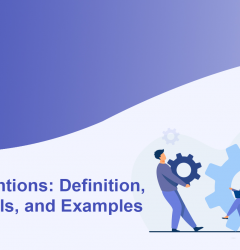28 Mar

This form of analytic activity has grown necessary in the last two years. Because of the COVID-19 epidemic, global labor markets have shifted considerably, and in August 2021, 55% of Americans expect to search for a new job over the next 12 months.
Employee attrition analytics focuses on determining why workers leave willingly, what may have stopped them from leaving, and how we can utilize data to anticipate employee attrition risk. Most significantly, this form of employee predictive analytics may aid firms in understanding and designing solutions that will be most effective in avoiding undesired turnover.
In this blog, we’ll discuss types of employee attrition, employee attrition analysis, employee attrition rate formula, employee attrition vs turnover, and many more.
Table of Contents
What Is Employee Attrition?
Employee attrition happens when the size of your staff shrinks over time owing to unavoidable variables like employee departure for personal or professional reasons. Employees are departing the employment at a rate that exceeds the rate at which they are employed, and this is often beyond the employer’s control. Assume you’ve recently built a new office designated as your company’s Sales Hub.
Every salesman is required to work out of this office – however, a few people are unable to relocate and have chosen to leave the firm. This is a common reason for staff turnover. However, there are additional causes for employee attrition, such as a lack of professional development, a hostile work environment, or a decline in trust in the company’s market value. Ineffective leadership is another factor that contributes to attrition.
Types Of Employee Attrition
1. Voluntary attrition
Employees who just left their employment are the most typical sort of attrition. There are several causes for voluntary attrition (more on that later), and the majority of them are under your control. You should take proactive steps to reduce voluntary turnover among high-value employees since this can reduce productivity over time. For example, if a corporation notices its marketing professionals leaving various business units, this is the reason for alarm.
2. Involuntary attrition
The corporation, not the employee, initiates the leave in this circumstance. For example, the employee may have engaged in workplace misbehavior, which is a typical cause of involuntary attrition. Attrition might also be caused by structural factors. Mergers and acquisitions can result in a wave of involuntary attrition.
3. Internal attrition
Employees are resigning from one department to work in another. Internal attrition can be beneficial in some circumstances since it directs talent toward more profitable areas. It also guarantees that employees are more suited to their jobs. However, if a single department has seen a high rate of attrition in a given year, an investigation is warranted. Is there anything lacking from the job? Is the management inexperienced? These are the kinds of questions that HR should be asking and answering.
4. Demographic-specific attrition
This is a major challenge for progressive businesses attempting to create an equal-opportunities environment. Employees from a single demographic — women, ethnic minorities, individuals with disabilities, veterans, or senior professionals – are departing the organization in large numbers. You must conduct employee surveys as soon as possible to determine the core reason for demographics-based attrition before it has an impact on your workplace culture. A good culture can serve as an antidote to the smoking pandemic.
Reasons for Employee Attrition
Following are the most common employee attrition reasons:-
- Retirement
Employees reach a specific age and decide to retire.
- Resignation for personal or life events
Employees may quit for personal or life circumstances unrelated to work. For example, an employee may relocate owing to the employment of a spouse or partner, or they may have a new kid and opt not to work. Other employees may leave for personal reasons that are not revealed to the company. Employees may not return to work after taking a personal leave of absence.
- Switching careers
Employees may decide to return to school or change occupations.
Benefits of Employee Attrition
Employers strive to limit turnover since it is expensive to recruit and train new employees. However, when an employee quits a company voluntarily, the employer may reap the following benefits:
1. Reduced labor costs
To avoid layoffs, employers may choose to institute a hiring freeze. Layoffs that occur as a result of a company change or reduction impair employee morale and make it difficult to hire for new roles. When employees depart of their own will, the organization can save money while making other recruiting selections.
2. Shifting of resources
Employers can delegate additional obligations to other workers, adjust departmental workflows, or relocate resources within an organization by opting not to fill a job.
3. New dynamics
Attrition provides an opportunity for fresh ideas and dynamics. It may revitalize an organization and provide new chances to present personnel.
Consequences of Employee Attrition
- This might be the outcome of a more significant problem in the workplace.
- Prevents you from concentrating on your job: growing the firm.
- Employee replacement is a time-consuming and costly operation.
- If you’ve only recently filled the position, you may have to pay for it again.
- While HR is working feverishly to fill that position, they are not focusing on filling other, equally vital positions.
What Is Employee Attrition Rate?
Attrition compares the number of individuals who departed a company/office/department to the average number of persons employed in that year. This includes new employees as well. Here’s a basic method for calculating attrition:
- Conduct a headcount to determine how many staff you have at the start of the year. Assume this number is 1,000.
- Keep track of how many individuals leave throughout the year. Assume 200 people leave the firm for a variety of reasons, both voluntarily and involuntary.
- Keep note of anyone you hire during the year and do a final headcount at the end. Assume you employed 400 individuals that year, bringing your total workforce to 1,400.
- Determine the average number of workers during that year. In our case, this is (1000+1400)/2 = 1,200.
- Finally, divide the number of workers who departed by the average number of employees. This gives you the attrition rate: (200/1200) times 100 = 16.66%.
Simply put, the employee attrition rate formula.
Attrition rate = number of employees / average number of employees x 100
As you can see, embarking on a recruiting drive will not mitigate the impact of attrition. This is why it is such an essential statistic for businesses.
Employee Attrition vs. Employee Turnover
While many individuals use both phrases interchangeably, the crucial distinction is that turnover accounts for all terminations, including those that are renewed. Attrition considers long-term vacancies or complete position eliminations.
Your firm is decreasing if your attrition rate is high. You may have a high turnover rate while yet running a steady or even expanding business. Restaurants and retail, for example, frequently have significant turnover rates, even as the firm increases.
Employee Attrition Prediction
The Attrition Prediction model evaluates the attrition risk for your employee populations in real-time, and it is revised each time an employee provides input. The aggregated, segment-level view ensures that your forecasts are accurate while maintaining individual employee identities.
Factors Affecting Employee Attrition
You are already aware of the leading causes of employee attrition. Consider the following factors for voluntary attrition:
1. Motivating factors
A change in an employee’s personal life has compelled them to shift occupations. New parents may choose to relocate to a place with superior schools, while a mid-career professional may wish to return to school for a variety of reasons. You may remain in touch with these workers and guarantee that they consider your firm in the future when they have the opportunity by conducting extensive departure interviews.
2. Workplace challenges
This is another prevalent cause of attrition. Workplace challenges might range from uncooperative leadership to a lack of necessary instruments for the job. This form of attrition is quite simple to correct. Request regular feedback, listen to the employee’s voice, and rectify any gaps in their employee experience. A person who is satisfied with their employment is unlikely to resign if the majority of their working criteria are met.
3. Professional motivation
This is where human resources may play a significant role in reducing attrition. An employee may depart because they believe there aren’t enough prospects for advancement in your firm. This is the situation in several technological firms, where technical talent is compelled to compete for management jobs as they advance up the corporate ladder. Take a cue from Microsoft, which established a long-term technical track to minimize professionally driven departure.
4. Poor employee-to-job fitment
We’ve all seen employees who enter a firm with zeal, only to quit a month or two later. This might be an indication that the position was not a good fit for the individual in the first place. You may reduce attrition caused by this issue by fine-tuning your job descriptions and onboarding procedure. Employees will know exactly what to anticipate, and new-hire attrition will be reduced.
Employee Attrition Analytics
It’s critical to understand that there are two sorts of attrition issues: too little and too much.
Many executives, with good reason, focus on the issue of excessive turnover when discussing attrition. Every year, businesses spend billions of dollars on recruiting, hiring, onboarding, and training new workers. When there is a high level of continual turnover in the workforce, companies suffer productivity losses – and lost earnings.
Top talent, in particular, is notoriously difficult and costly to replace. The stronger the worker’s talent, the bigger the repercussions of attrition: Individual employee replacement generally costs one-half to two times the worker’s yearly compensation.
Aside from financial concerns, organizations benefit from retaining good personnel and the organizational expertise they hold.
Too little attrition, on the other hand, can be a concern. It is preferable to have the proper level of attrition, with the right individuals leaving at the right time.
Not every organization or position is a good match for everyone; if an employee who isn’t a good fit or a low-performing employee quits, there’s a chance to fill the post with a high performer who is a better fit for the job.
Even if a good employee quits as a result of “graduating” into a job with a customer, it may be a beneficial loss if they become a fantastic advocate for the firm.
There may also be positions inside the business that are transitional roles, where individuals are expected to have just a limited tenure before moving on to another position, either internally or externally. Employees in these sorts of roles may not be kept in their employment eternally, but rather for a few months longer to prevent turnover costs and disruption.
The purpose of employee attrition and retention is to achieve the correct balance between retaining top talent and admitting that some turnover is healthy; employee attrition analytics helps firms discover that balance.
Practices to Reduce Employee Attrition Rate
There is an obvious disadvantage to attrition: your team diminishes, you lose key product/domain expertise, and you risk harming your employer brand.
- At the time of hire, evaluate the job and cultural fitting.
- Provide learning and development opportunities to employees to help them advance in their careers.
- Solicit input on employee satisfaction issues regularly.
- Ensure a competitive compensation package in comparison to other firms.
- Conduct extensive exit interviews after an employee has left to identify attrition tendencies.
Now that you understand the concept of attrition and its different intricacies, you may approach this measure with clarity and knowledge. Remember that there is no one-size-fits-all methodology for defining the reasons for employee departures. To remain ahead of the attrition curve, segment the staff into particular groups, employ cutting-edge people analytics, and track progress year after year.
How can HR ensure that attrition benefits the company?
HR leaders may assist their organization’s profit from attrition by implementing the following practices:
1. Consider working at a variety of jobs
HR executives may react to the changing nature of the job market by doing research and gathering data to plan for various sorts of employment inside the firm. Some vital core workers may be able to become full-time employees, while others may be employed as contingent workers or independent contractors. As always, HR directors must evaluate both the needs of the organization and the needs of individual employees.
2. Keeping employees is crucial to a company’s success.
HR executives may focus on engaging and keeping the most influential and important workers for company development and progress once they have identified the most influential and important people for company growth and advancement.HR executives can boost the odds of retaining talented workers by offering competitive remuneration packages, opportunities for personal and professional growth, and developing a business culture based on trust, gratitude, and respect.
3. Provide a warm-offboarding program.
Human resource managers can implement an offboarding program that allows workers to leave on good terms. It’s critical to send leaving employees farewell with thanks and best wishes for the next step in their professional careers. Employers demonstrate integrity in this manner, and workers may act as positive advocates for their ex-employer.
4. Keep the door open to allow staff to return.
HR professionals may collaborate with managers and executives to create rules and a business culture that encourages boomerang workers. Employees with valuable knowledge, experience, and passion who leave a firm and subsequently opt to return have the opportunity to offer their important information, experience, and enthusiasm.
How can employee attrition improve company culture?
Attrition occurs even in the best of working environments. While it is frequently painful to let go of workers, attrition may provide HR professionals with the opportunity to reassess and realign their recruitment and hiring strategies with the company’s goals and values. Attrition can also create possibilities to recruit elite talent or persons who are better suited to certain professions.
Accepting the present increase in attrition may assist HR leaders, managers, employees, and executives in developing a business culture that promotes personal growth, fulfillment, and success.
Can Employee Attrition be beneficial?
Surprisingly, attrition isn’t necessarily a negative thing. In many circumstances, turnover can be beneficial to a company for the following reasons:
- Employees that perform poorly depart your organization, lowering overhead and making a place for fresh talent.
- Attrition can facilitate diversity in one-dimensional settings (for example, tech corporations employing a disproportionately large number of males).
- It weeds out people who aren’t a good match for their position and were probably never hired in the first place.
- It contributes to a more dynamic workforce since the same people with the same viewpoints aren’t leading the firm for decades.
- It is essential during structural changes, such as when pivoting to a new corporate direction or when there is inadequate funding.
When examining your staff attrition rate, keep these considerations in mind. To determine the impact of attrition on your firm, consider the type of talent lost and why they departed.
Wrapping It Up
Many businesses concentrate solely on staff turnover rates, yet this can lead to the omission of critical information. You need to know if your organization is losing individuals, why, and what you can do to fill skill shortages. According to recent research, the majority of individuals resign for reasons that firms might improve.
Understanding the reasons for employee attrition in your business and having an overview of your attrition rates can allow you to implement long-term workforce planning strategies to control attrition so that it does not harm your firm.
Frequently Asked Questions (FAQs)
How to manage attrition?
- Foster a pleasant work environment. An employee’s work environment is the place where they carry out their duties.
- Appoint the right leadership.
- Give employees creative freedom.
- Prioritize professional growth.
- Offer competitive compensation and benefits.
What is the main challenge with attrition?
The most cited reason for attrition is that employees cannot get along with their managers. Research has shown that there are many reasons for attrition. Management experts and organizational behavior theorists often use the phrase “employees leave managers, not organizations.”.












Himani